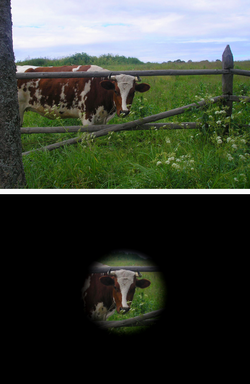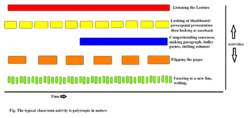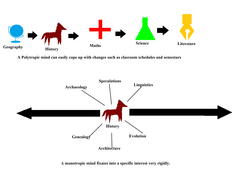Philosophy:Monotropism
Monotropism is a person's tendency to focus their attention on a small number of interests at any time, tending to miss things outside of this attention tunnel. This cognitive strategy has been posited as the central underlying feature of autism. The theory of monotropism was developed by Dinah Murray, Wenn Lawson and Mike Lesser starting in the 1990s, and first published in 2005.[1] Lawson's further work on the theory formed the basis of his PhD, Single Attention and Associated Cognition in Autism, and book The Passionate Mind published in 2011.
A tendency to focus attention tightly has a number of psychological implications. While monotropism tends to cause people to miss things outside their attention tunnel, within it, their focused attention can lend itself to intense experiences, deep thinking and flow states.[2]
However, this hyperfocus makes it harder to redirect attention, including starting and stopping tasks, leading to what is often described as executive dysfunction in autism, and stereotypies or perseveration, where a person's attention is repeatedly drawn back to the same subject or activity.
Characteristics
Since the amount of attention available to a person is limited, cognitive processes are forced to compete. In the monotropic mind, interests that are active at any given time tend to consume most of the available attention, causing difficulty with other tasks such as conventional social interaction. Language development can be affected, both through the broad attention required and the psychological impact of language, which provides a tool for others to manipulate a child's interest system.[1]
Monotropic individuals have trouble processing multiple things at once, particularly when it comes to multitasking while listening. For example, some students have trouble taking notes in class while listening to a teacher[3] and may find it difficult to read a person's face and comprehend what they are saying simultaneously.[1] A common tendency is for individuals to avoid complex sensory environments because of this hypersensitivity.[3] Monotropic individuals may suppress attention and focus on something else, or develop great depth in a given interest or skill.[4]
Implications for practice
Murray et al. (2005) proposed certain steps to help autistic individuals, such as increasing 'connections', building understanding through the child's interests, and making connections between people and concepts more "meaningful and less complex."[1]
See also
- Autism and memory
- Caetextia
- Monomania
- Idée fixe
- Introversion
- Obsessive–compulsive personality disorder
References
- ↑ 1.0 1.1 1.2 1.3 Murray, Dinah; Lesser, Mike; Lawson, Wenn (2005). "Attention, monotropism and the diagnostic criteria for autism". Autism 9 (2): 139–56. doi:10.1177/1362361305051398. PMID 15857859. https://monotropism.org/murray-lesser-lawson/.
- ↑ Andy, McDonnell; Damian, Milton (2014). "Going with the flow: reconsidering 'repetitive behaviour' through the concept of 'flow states'". in Jones, Glenys. Good Autism Practice: Autism, Happiness and Wellbeing. Birmingham, UK: BILD. pp. 38–47. ISBN 9781905218356.
- ↑ 3.0 3.1 Bogdashina, Olga (2003). Sensory Perceptual Issues in Autism and Asperger Syndrome: Different Sensory Experiences – Different Perceptual Worlds. London: Jessica Kingsley Publishers. ISBN 9781843101666. https://books.google.com/books?id=RCQ1U38WmjIC&dq=monotropism+autism&pg=PA11.
- ↑ Lesser, Mike; Murray, Dinah (2020). "Mind as a Dynamical System: Implication for Autism". in Murray, Dinah. The Neurodiversity Reader. Shoreham by Sea: Pavilion. ISBN 9781912755394. https://monotropism.org/dinah/mind-as-a-dynamical-system/.
Further reading
- Lawson, Wenn (2011). The Passionate Mind: How People with Autism Learn. London: Jessica Kingsley Publishers. ISBN 978-1-84905-121-7.
- Murray, Dinah (2021). "Monotropism: An Interest-Based Account of Autism". in Volkmar, Fred R.. Encyclopedia of Autism Spectrum Disorders (2nd ed.). Springer. pp. 2954–2956. doi:10.1007/978-3-319-91280-6_102269. ISBN 978-3-319-91279-0. https://monotropism.org/dinah/monotropism-2020/.
- Murray, Fergus (30 November 2018). "Me and Monotropism: A unified theory of autism". The Psychologist (The British Psychological Society). https://www.bps.org.uk/psychologist/me-and-monotropism-unified-theory-autism.
External links
- monotropism.org Information portal on monotropism, including an archive of Dinah Murray's work on the subject
 |





